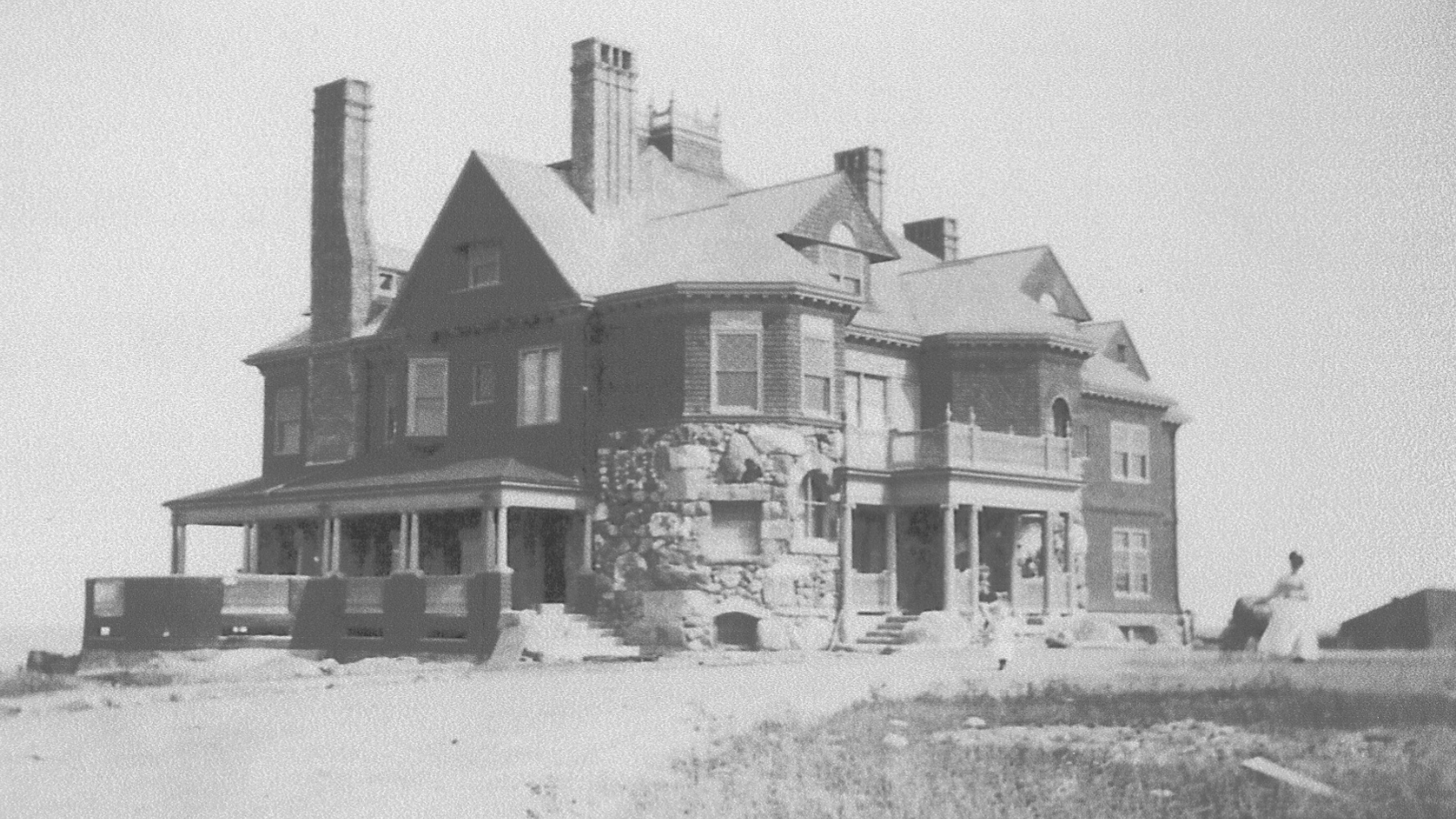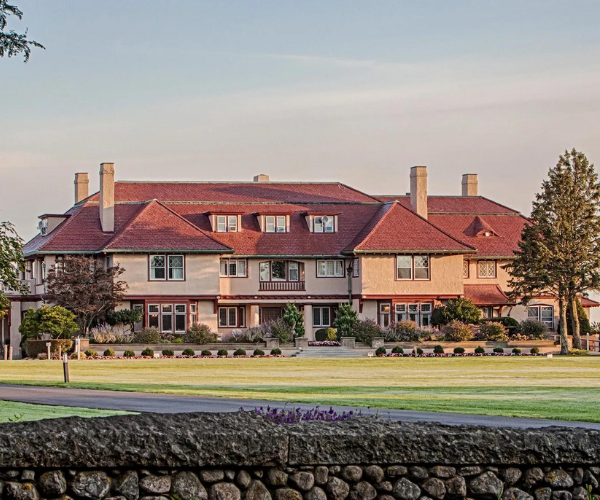Receive for Free - Discover & Explore eNewsletter monthly with advance notice of special offers, packages, and insider savings from 10% - 30% off Best Available Rates at selected hotels.
history
Discover The Mansion at Ocean Edge, which was once the summer estate for the renowned Nickerson family.
The Mansion at Ocean Edge, a member of Historic Hotels of America since 2022, dates back to 1907.
VIEW TIMELINEThe Mansion at Ocean Edge, built in 1907, and a member of Historic Hotels of America since 2022, was listed in the National Register of Historic Places in 1986. While this historic structure has stood for more than a century, it has not always been a luxurious boutique hotel. On the contrary, The Mansion at Ocean Edge was once the beautiful manor house for the influential Nickerson family. In the late 19th century, a renowned Chicago-based financial tycoon named Samuel Mayo Nickerson purchased 48 acres of undeveloped land on the outskirts of Brewster, Massachusetts. At the time, one of the most expensive homes constructed in the United States after investing more than $450,000 into its creation, Nickerson’s gorgeous estate included a palatial Victorian mansion at its center called “Fieldstone Hall” along with an elaborate Tudor-style stable on the hill overlooking Cape Cod Bay. The project proved to be massive in scope, taking several years to finish. While Nickerson and his wife, Mathilda, would spend many summers at Fieldstone Hall, he had actually built the facility with his son Roland in mind. Roland’s health was constantly in a state of flux, and Samuel had hoped the residence would give his son a much-needed place to relax. Excited, Roland, his wife Addie, and their children began making regular trips to Fieldstone Hall as soon as it opened in 1890. Indeed, Roland and Addie enjoyed their time so much at Fieldstone Hall that they even considered it to be something of a second home. Nevertheless, misfortune soon occurred when all of Fieldstone Hall experienced a great structural accident a few years later. Roland had also passed away not long thereafter as well, thus furthering the family’s hardship.
Unshaken from the tragedies, Addie Nickerson decided to rebuild her family’s estate. Work on the new building began in 1907 and lasted for nearly five years. Architect Horace Frazer crafted its magnificent appearance on behalf of the Nickersons, using an eclectic blend of different architectural styles to craft its brilliant façade. Gorgeous stucco tiling formed most of the exterior, while imported Italian marble was placed throughout the interior. Perhaps the building’s most impressive feature was the masterfully carved oak staircase that ascended to the second floor. When the new “Nickerson Mansion” finally made its grand debut, it stood as one of the most architecturally impressive buildings in all of Cape Cod. Addie and her own son, Roland Jr., moved into the building right as Frazer installed the final architectural touches. The building would subsequently remain in the Nickersons over the next few decades, until the family decided to sell it to the Missionaries of La Salette in 1945. (Bishop James E. Cassidy specifically approved the sale.) Costing $25,000 to acquire, the order subsequently integrated the building into a larger complex that operated as a seminary. But during the early 1980s, Corcoran Jennison purchased the erstwhile mansion for just under one million dollars and transformed it into a luxurious hotel that would be part of a much larger resort called the “Ocean Edge Resort & Golf Club.” Jennison himself oversaw the design, in which he passionately preserved its amazing historical character. Known today as the “The Mansion at Ocean Edge,” this historic setting has become one of Cape Cod’s most exclusive vacation retreats. Travelers will relish its rich institutional heritage and wonderful historical architecture.
-
About the Location +
Located along the quaint shoreline of Massachusetts Bay, Brewster, Massachusetts, is just one of the handful of communities that reside in picturesque Cape Cod. Cape Cod has a long and storied history that harkens back to the very origins of the nation. Indeed, in 1620, the first settlers to arrive from Europe landed on the northernmost tip of the Cape in what is now Provincetown. (European explorers had investigated the site several years prior, with one adventurer—Bartholomew Gosnold—giving it the name “Cape Cod” for the first time.) The settlers themselves were the Puritans, English religious refugees now remembered today as the “Pilgrims.” At first, the Puritans found readily available resources, but the winter proved tough. Thanks to the native Wampanoags and Nauset peoples, the Puritans learned to live off the land through the inhospitable weather. To govern themselves, the Puritans even created the “Mayflower Compact,” which formed the first self-governing body in the “New World.” The surviving Puritans then left the Cape after a few weeks, where they established the town of Plymouth further inland. Nevertheless, Cape Cod continued to attract English immigrants over the following decades, who created more than a dozen villages like Barnstable, Sandwich, and Yarmouth. Brewster itself formed in 1656 from a town called “Harwich”—its name actually paid tribute to a prominent Pilgrim named “Elder William Brewster.”
The region remained under the authority of Plymouth Colony for generations until it was annexed by neighboring Massachusetts in the 1690s. Cape Cod was driven by agriculture for a while, with farmers growing crops like wheat. But fishing eventually overtook farming as the primary local trade by the late 18th century, particularly the phenomenon of whaling. Unlike the rest of Massachusetts, Cape Cod remained pastoral in character as large-scale industrialization bypassed the region. This subsequently preserved its stunning geography, which became a great source of entertainment throughout the 19th century. Writers like Joseph C. Lincoln published numerous stories and novels that romanticized the Cape’s pastoral nature, inspiring greater numbers of people to travel east to experience its majesty. By the height of the Gilded Age, those individuals had begun constructing their own brilliant mansions across Cape Cod in towns like Bourne, Falmouth, and Brewster. Some of the most influential figures in the country even maintained a summer “cottage” in the area, including President Grover Cleveland. Ordinary Americans started to frequent the Cape for vacations over time, especially once the modern middle-class began to emerge in the early 20th century. Several outstanding hotels and resorts opened as such, creating a vibrant tourism industry that brough new economic life to the region.
Cape Cod has since maintained its prestigious status as a major American holiday destination. Tourism continues to sustain the regional economy, with thousands of enthusiastic travelers congregating along its beaches every year. Many prominent Americans continue to grace Cape Cod with their presence, such as the iconic Kennedy family. (In fact, the Kennedys still maintain a massive vacation compound in nearby Hyannis Port.) Cultural heritage travelers in particular enjoy visiting Cape Cod, as the area is replete with amazing attractions and landmarks. Fascinating historic sites—including the Hoxie House in Sandwich and the Pilgrim Monument in Provincetown—abound throughout Cape Cod, as do wonderful natural heritage locations. The Cape Cod National Seashore is perhaps the region’s biggest draw, for it is one of the best places to go whale and bird watching in the entire United States. Visitors have also relished taking trips out to the outlying islands of Martha’s Vineyard and Nantucket, which are massive historic sites in their own right. But cultural heritage travelers also have fun just driving around to see the quaint Shingle-style homes and historic lighthouses that dot the landscape. (Among the best lighthouses available to see is the Nauset Lighthouse, the Chatham Lighthouse, and the Race Point Lighthouse.) Few places in the nation can truly rival the rich history and culture that defines Cape Cod today.
-
About the Architecture +
The Mansion at Ocean Edge possesses a unique architectural style that can best be described as “eclectic.” Dating to the mid-19th and early 20th centuries, historians today consider “eclecticism” to be part of a much larger movement to fuse together a variety of historical designs. Earlier in the 1800s, architects—particularly those in Europe—decided to rely upon their own loose interpretations of historical architecture whenever they attempted to replicate it. Such a practice appeared within such styles as Gothic Revival, Italianate, and Second Empire architecture. But at the height of the Gilded Age, those architects decided to use historic architecture more literally when developing a building. A few architects went a step further by combining certain historical styles together to achieve something uniquely beautiful. And in some cases, those individuals felt inspired to add a new historical form onto a building that they were renovating—just like The Mansion at Ocean Edge. Ultimately, the architects felt that joining such architectural forms together would give them a new avenue of expression that they otherwise did not have at the time. They also believed that they had stayed true to the earlier forms, so long as their designs perfectly replicated whatever it was they wanted to mimic.
In Europe, this approach first appeared as a rehash of Gothic Revival-style known as “Collegiate Gothic.” The European architects then used such a mentality to influence the unfolding philosophies of both the Beaux-Arts school of design, as well as the emerging Renaissance Revival-style. Many architects in America followed suit, the most notable of which being Richard Morris Hunt and Charles Follen McKim. The American architects who embraced “eclecticism” were at first interested in the country’s colonial architecture. Much of the desire to return to the time period was born from the revived interest in American culture brought on by the Centennial Exposition of 1876. Pride in preserving the nation’s heritage inspired the architects to perfect the design principles of their colonial forefathers in new and intriguing ways. This interest gradually splintered into other revival styles, though, like Spanish Colonial and Tudor Revival. Some Americans even infused the approach with the popular Beaux-Arts aesthetics of France, such as Hunt and McKim. Yet, the birth of Modernism in the 1920s and 1930s eventually ended the worldwide love affair with “eclecticism,” for architects throughout the West became more enchanted with the ideas of modernity, technology, and progress.































